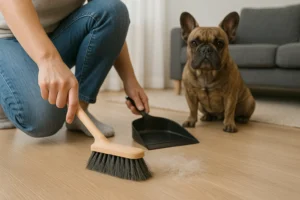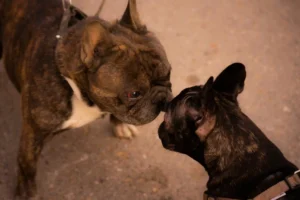Quick answer
Frenchies make funny little snorts because their noses are short and their breathing paths are narrow. Most of the time it’s harmless—especially after play, during cozy naps, or in a brief snorting “fit” that comes and goes. It’s not okay when breathing looks like hard work, the tongue or gums turn blue-gray, or the dog wobbles or collapses. That’s a vet visit.
Introduction
New Frenchie parents love the cute sounds—until they wonder: “Is this normal?” This friendly guide explains what’s behind the noise, three everyday moments when snorts are nothing to stress about, and one clear situation when help is needed. You’ll also get calm, practical steps to make day-to-day breathing easier at home.
Table of Contents
- Why Frenchies snort in the first place
- 3 times it’s cute (and normal)
- 1 time it’s a vet visit (red flags)
- Simple home playbook to reduce snorts
- Quick comparison table
- FAQs
- Wrap-up
Why Frenchies Snort in the First Place
Frenchies have charming, short noses. That cute face leaves less space for smooth airflow, so air can wobble and vibrate on the way in and out. Excitement, warm rooms, extra weight, tight collars, and fast eating can all make the sound louder. Some dogs breeze through life like this; others need a little help.
3 Times It’s Cute (and Normal)
1) After zoomies or happy greetings
Short, soft snorts right after play are common. They should fade within a minute or two once the dog settles in a cool spot. The dog stays bright-eyed, keeps the mouth mostly closed, and doesn’t look distressed. If the sound keeps getting harsher or the dog struggles at rest, that’s different—see the red flags below.
2) Cozy sleep snuffles
Gentle, rhythmic snoring in certain positions is typical. Many owners find that rolling a Frenchie onto the side or lightly raising the head quiets things down. What’s not normal: repeated start-and-stop breathing, gasping, or restless, broken sleep. When nights look like that, it’s time to talk to the vet.
3) Those brief “snorty episodes”
Sometimes a Frenchie will have a short burst of quick snorts where air seems to rush inward. It can be triggered by dust, leash pressure, or excitement. Most spells are short and stop on their own. Staying calm, offering a quiet pause, or gently stroking the throat often helps. If these episodes become long or frequent, get advice.
1 Time It’s a Vet Visit (Red Flags)
What to watch for
- Noisy, hard breathing even while resting
- Trouble handling mild exercise or warm weather
- Tongue or gums turning blue or gray
- Gagging, repeated choking sounds, or collapsing
- Pauses in breathing during sleep
Any of these signs means the dog may not be getting enough air. Call the clinic, describe what you see, and follow their guidance.
What to do right now
- Stop activity and move to a cool area
- Switch to a harness if a collar is tugging the neck
- Offer small sips of water; keep things calm and quiet
- Watch gum color and overall comfort while you contact the vet
Owner Playbook: Make Everyday Breathing Easier
Keep things cool and calm
Plan walks for cooler times, build short play bursts with rest breaks, and use fans or AC in stuffy rooms. A lean body keeps breathing easier—ask the clinic for a simple feeding plan if weight is creeping up.
Choose kinder gear and mealtime habits
Pick a front-clip harness to reduce neck pressure. Use a slow-feeder or snuffle mat to prevent gulping. Give a few smaller meals instead of one big bowl, and let excitement settle before eating or going outside.
When simple changes aren’t enough
If snorts turn into daily struggles, the clinic may suggest checks and fixes tailored to your dog. Many owners report brighter energy, better walks, and quieter sleep after getting help. The sooner you ask, the easier the plan.
Cute vs. Concerning (At-a-Glance)
| Scenario | Sounds like | Lasts for | Effort level | What to do |
|---|---|---|---|---|
| After play | Soft snuffles that fade | A minute or two | Easy breathing | Cool room, quick rest. |
| During sleep | Gentle, positional snore | On and off | Easy; settles when moved | Side-lying or slight head raise. |
| Short “snorty episode” | Fast in-breaths, looks dramatic but brief | Seconds to a minute | Brief, stops on its own | Stay calm; note triggers. |
| Red flags | Harsh noise at rest; blue-gray gums; collapse | Ongoing or worsening | Hard work to breathe | Call the vet now. |
FAQs
Do Frenchies outgrow snorting?
Not usually. The face shape stays the same, so good habits—cool spaces, kinder gear, steady weight, calmer transitions—go a long way. If snorts turn into daily struggles, ask for help.
Are those short snorty spells dangerous?
Most are harmless and pass quickly. Keep notes on what triggers them—dust, pulling on the leash, over-excitement—and adjust. If they become frequent or last longer than a minute, check in with the clinic.
Can trimming a little weight really help?
Yes. A few lost pounds can make breathing quieter, walks easier, and summer days safer. Pair portion control with slow, fun activity and lots of shade.
Wrap-Up
So, why do Frenchies snort? Short noses and narrow breathing paths make the sound common—and in three everyday moments, it’s simply part of the charm. Learn the red flags, keep life cool and calm, use a harness and slow-feeding, and ask for help if rest time gets noisy or effortful. With small, steady tweaks, most dogs breathe easier and enjoy happier days.
Disclaimer: Always consult a certified veterinary doctor for your dog’s health problems.
References
- Reverse sneezing explained (what it is & when to call the vet) — VCA Animal Hospitals. (Vca)
- Reverse sneezing overview for dog owners — Cornell University College of Veterinary Medicine. (Cornell Vet College)
- Why some short-nosed dogs make more noise (Cambridge BOAS Research Group) — University of Cambridge. (vet.cam.ac.uk)
- Simple grading test for noisy breathing (RFGS) — The Kennel Club (UK). (The Kennel Club)
- The same grading test now available in North America — OFA. (OFA)
- What worrying signs can look like in flat-faced dogs — VetMed Illinois. (Veterinary Medicine at Illinois)
- First steps during a breathing emergency — MSD Veterinary Manual (pet owner section). (MSD Veterinary Manual)
- Program news on the grading scheme for short-nosed breeds — Royal Veterinary College. (rvc.ac.uk)
- Reverse sneezing: owner guide — Veterinary Partner (VIN). (Veterinary Partner)
- Breathing problems: what to do right away — Veterinary Partner (VIN). (Veterinary Partner)



